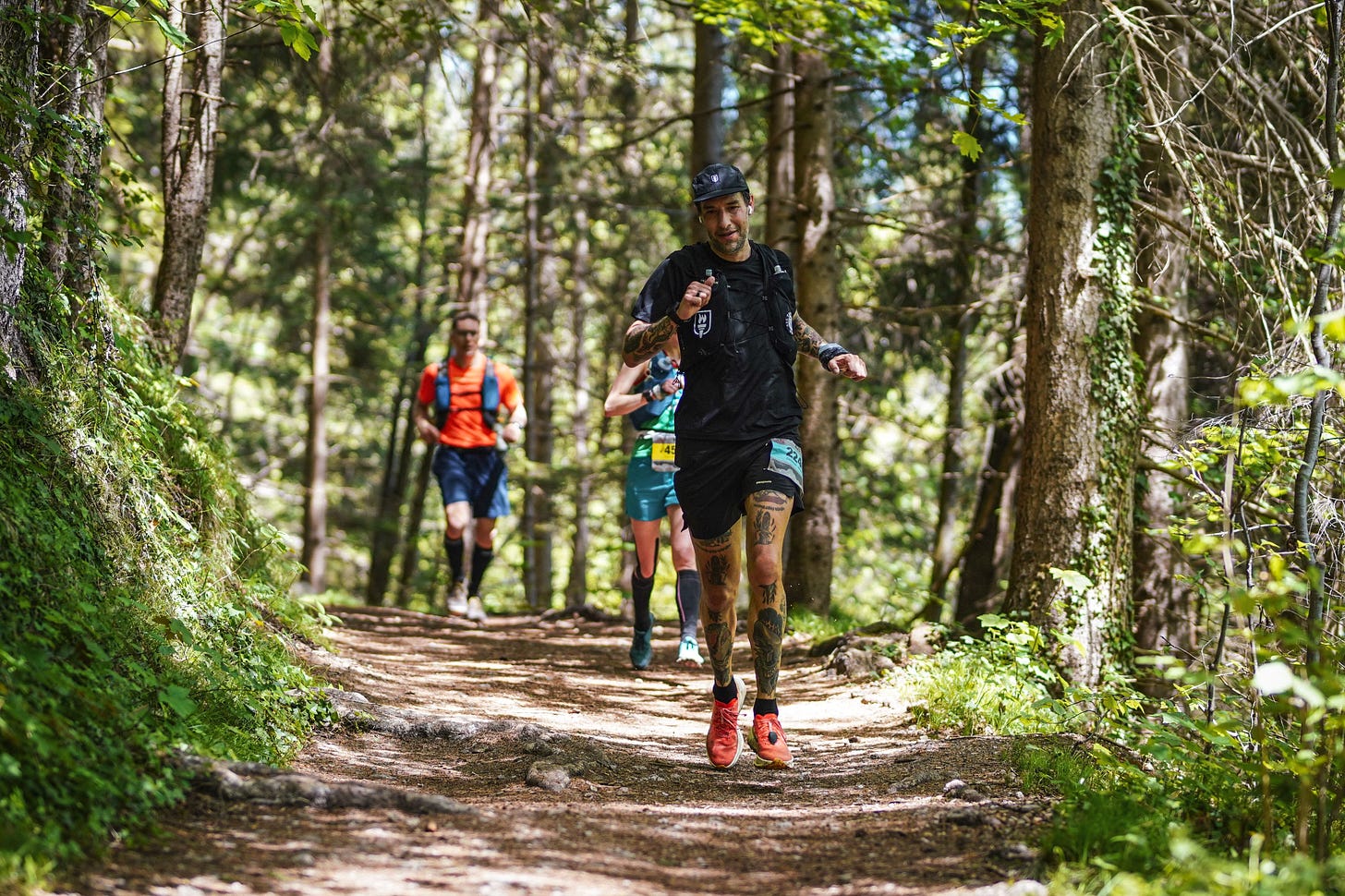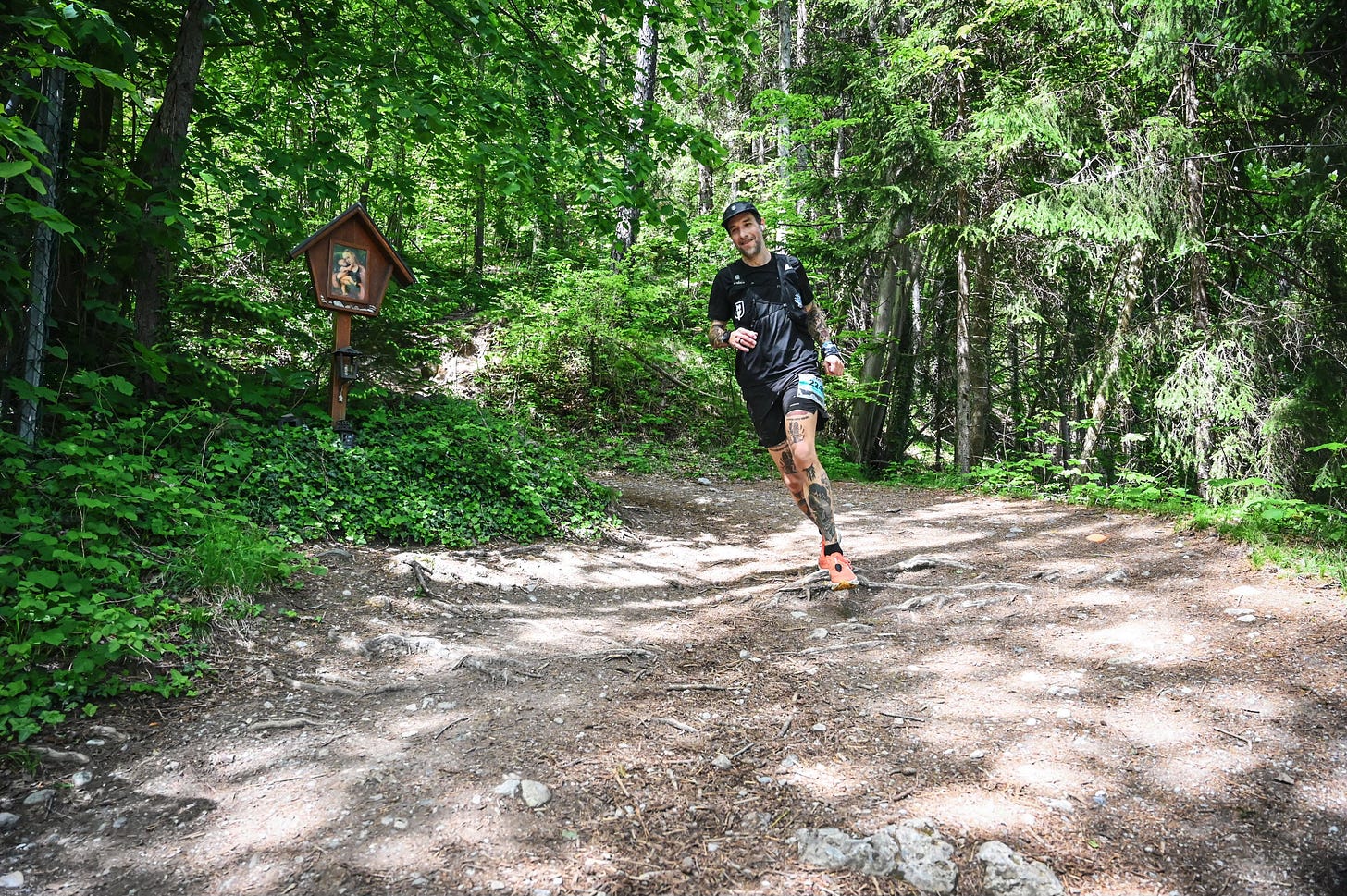PART ONE: A Trail Race in Context
I Talked to the Mountain and She Let Me Pass
Last weekend I participated in my first post-marathon season race. I ran the K25, the 26k distance at the Innsbruck Alpine Trailrunning Festival (IATF). Here’s what happened.
It is not usual to go to a tennis tournament without hitting a few balls on the court first. However, my preparation for the IATF was very similar. Of course, running is running and I already had a lot of that in 2024, but on the other hand, trail running is a completely separate sport with very specific requirements that have only little to do with road running.
But I didn't care. You have to start somewhere and the K25 at the IATF was chosen to kick off my trail summer.
First things first: it was a good choice.
From the first kilometer, no, already in the starting block, I felt very comfortable in my skin and in my surroundings. The start was in an après-ski style ski lift hut with perfectly matching music blaring from the speakers, but only two turns later I was running with a group of runners on forest paths, dirt roads and single trails.
A Runner’s No Man’s Land
"Group of runners" is a good keyword. Unless I have an exceptionally good or exceptionally bad day, I always run in the so-called "no man's land". This happens to me no matter if I'm racing a local 10k or an ultramarathon. By “no-man's-land”, I mean that the really good runners are way ahead of me, and the broad mid-pack is way behind. There's usually not much going on where I run. It can be a lonely ride.
At the IATF, however, I was lucky enough to run with a couple of super strong women. By super strong, I mean that the women in this section were extremely consistent and focused. I think the typical "I'll pass you with my last ounce of strength and get caught again a few minutes later" game is more of a male thing. It was great to witness how the women around me tackled the race.
Out of Place
I'm not known for writing the typical (boring) race report, so I'll spare you the details like passing times at the aid stations, which trails were particularly "flowy" and which climbs particularly "crunchy" (Germans often use the phrase “knackiger Anstieg” which makes me cringe every time). Just this much: large parts of the IATF felt like a road race to me. This was definitely because the course was, indeed, quite runnable. On the other hand, it was also due to the fact that the race still corresponded to my remaining mind- and skillset of a marathon runner. With the appropriate shoe I was wearing, which also felt like a road racer, the illusion was almost perfect.
The Mountain Opened its Arms and Paths
It wasn't until about halfway through the race, after the Kranebitten aid station, that the mountain opened its arms and paths to me. Although I was already quite tired, I felt increasingly calm and relaxed. Almost indifferent, but in a positive way.
It didn't matter if I was going uphill or downhill.
It didn't matter that it was hot.
It didn't matter that I had tied my shoes too loosely.
It didn't matter if I was passing someone or being passed.
It didn't matter that the carbohydrate drinks in my two flasks tasted strikingly different, even though I had filled them with the same powder.
It didn't matter how far or how long I had run and still had to go.
A wonderful feeling of positive indifference that carried me all the way to the finish.
Home Stretch
The last few hundred meters of the IATF are really something. After the mountain spits you out, you run along the Inn for about a kilometer until you turn onto a 400 meter home stretch that is packed with spectators on both sides. This gathering of people included my friends and my lovely wife, Lisa, as well as a lot of smiling strangers. A really great finish that makes many runners forget the pain and effort of the last few hours.
I can't tell you about the pain and the effort. Not even about the hours. My race lasted just under 2.5 hours, although it felt much longer. In a positive sense.
I have fond memories of the race and am glad that I didn't listen to the Levelhead who told me that you have no business in the mountains without proper preparation. In the case of the IATF, the Punk's impulse to just do what you feel like doing was the right one.
My next race is the 5000m at the Track Cup Karlsfeld. Yes, that is correct. A 5000m track race. Funny, isn’t it.
PART TWO: A 5k Personal Best in Context
On Wednesday my coach Karim asked me what my 5k PB was. He needed this information to set up a an appropriate training schedule for my upcoming track races. I didn't know the PB off the top of my head and had to look it up (If you're interested in that sort of gibberish, my personal bests on Strava are reasonably current and well maintained).
I was at first disappointed and then flattered by the result.

The Disappointment
Objectively speaking, I thought my 5K time was way too slow. I don't even mean in comparison to other runners, just the sheer number. I found it kind of unsexy. Like a 3:01 marathon or a 40:01 10K (the numbers are interchangeable). I immediately felt the urge to “correct” my PB and replace it with a better time.
The Pride
But the more I thought about it, the more I began to enjoy my personal best in the 5k. Maybe joy is not the right word. It was more a feeling of pride that washed over me.
In Context
This feeling came the moment I put the naked number into context. My context.
I am 45 years old and only started running at the age of 35. With a body weight of 105 kilos, mind you. For the first few years, I didn't have a single other runner around to learn from. Not even how to tie my shoes properly (see above).
This was followed by a completely chaotic Sturm und Drang phase in which I trained myself to burnout several times with a relentless "faster, higher, further" and "too much, too soon" attitude.
It's only been 3 years since I calmed down as a runner and started training halfway smart. By smart, I mean that it is good for me mentally and physically, but also that my training is actually improving my performance. I may be fighting the biological clock – we all do at a certain age – but the leaps in development, especially in the last few months, have been far greater than the physical decline.
In this context, my current personal best in the 5K is something to be very proud of, and I am.
I'll leave it at that for now. This isn't going to be a "Running at age 45" article (I'll save that for later, haha!), but my takeaway this week is that performance must always be seen in the context of the individual athlete. Or to put it in less general terms:
In the future, I will try to look at my performance in my context.
This way, a "Never fast enough" (which I have tattooed on my thigh, by the way) quickly turns into a "Wow, that's awesome!" and given the choice, I'll take the latter.
Everything Not Running
Since this Das Z Letter was already a double feature with 2 different topics, today's "Everything Not Running" section only contains the information that there are two new and hot Das Z [+] Letters out now.
As always, they are bilingual, in English and German. You can read them if you are tempted to become a paid subscriber.
There are many reasons for this, but probably the most important one is that you can show me very clearly that you like and appreciate the Das Z Letter and the Das Z Sprachnachricht. Which, in return, makes me very happy. Thank you so much.







![[+] Solitude – About Running Alone](https://substackcdn.com/image/fetch/$s_!BfxS!,w_140,h_140,c_fill,f_auto,q_auto:good,fl_progressive:steep,g_auto/https%3A%2F%2Fsubstack-post-media.s3.amazonaws.com%2Fpublic%2Fimages%2Fda8713cd-125b-49fa-83c2-aebd20c7481e.heic)
![[+] Unison – About Running Together](https://substackcdn.com/image/fetch/$s_!HXgK!,w_140,h_140,c_fill,f_auto,q_auto:good,fl_progressive:steep,g_auto/https%3A%2F%2Fsubstack-post-media.s3.amazonaws.com%2Fpublic%2Fimages%2F2c1eef9e-5bc6-4191-a4e5-c1a505f6f72d.heic)
While running in the "no man's land" I cracked my head multiple times. But the paths trough this lands are the most honest. For me there is no better way than running multiple kilometres alone through the competition to find out if l'm completely committed to the race. Racing in groups is motivating as fuck, but struggling in the forrests of the no man's land is a deeper experience.
Even 7 years later, I find it hilarious that we ran the exact same race (and even heat!) together without knowing each other. Belated congrats on that PR, here's to breaking it soon!